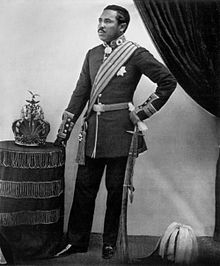Radama II
| Radama II | |
|---|---|

Radama II with crown, 1861
|
|
| King of Madagascar | |
| Reign | August 16, 1861 – May 12, 1863 |
| Coronation | September 23, 1862 |
| Predecessor | Ranavalona I |
| Successor | Rasoherina |
| Born | September 23, 1829 Imasoandro, Rova of Antananarivo |
| Died | May 12, 1863 (age 33) – contested Rova of Antananarivo – contested |
| Burial | 1863/1897 – contested Ilafy/Tomb of the Kings, Rovan'Antananarivo – contested (re-interred) |
| Spouse |
Rasoherina (as Rabodo) Ranavalona II (as Ramoma) Marie Rasoamieja |
| Dynasty | Hova dynasty |
| Father |
Andriamihaja Radama I (officially) |
| Mother | Ranavalona I |
Radama II (September 23, 1829 – May 12, 1863 [assumed dead]) was the son and heir of Queen Ranavalona I and ruled from 1861 to 1863 over the Kingdom of Madagascar, which controlled virtually the entire island. Radama's rule, although brief, was a pivotal period in the history of the Kingdom of Madagascar. Under the unyielding and often harsh 33-year rule of his mother, Queen Ranavalona I, Madagascar had successfully preserved its cultural and political independence from French and British designs. Rejecting the queen's policy of isolationism and Christian persecution, Radama II permitted religious freedom and re-opened Madagascar to European influence. Under the terms of the Lambert Charter, which Radama secretly contracted in 1855 with French entrepreneur Joseph-François Lambert while Ranavalona still ruled, the French were awarded exclusive rights to the exploitation of large tracts of valuable land and other lucrative resources and projects. This agreement, which was later revoked by Prime Minister Rainilaiarivony, was key to establishing France's claim over Madagascar as a protectorate and, in 1896, as a colony.
The dramatic contrast between Ranavalona's isolationism and her son's pro-European stance represented an abrupt reversal of policy that threatened the traditional sociopolitical order. Radama's absolutism in pursuing dramatic reforms in disregard of the advice of his ministers ultimately turned them against him. In a coup led by his Prime Minister, Rainivoninahitriniony, Radama II was strangled on May 12, 1863. His wife Rabodo, who took the throne name Rasoherina, was allowed by the ministers to succeed her husband on the condition that she and future sovereigns would no longer rule unilaterally, but rather in concert with the Hova (the class of free citizens) as represented by the position of Prime Minister. The public was informed that Radama had committed suicide and that his body had been unceremoniously interred in a tomb in Ilafy. However, there soon emerged rumors – believed by prominent foreigners Jean Laborde and William Ellis – that Radama lived and was making plans to reclaim the throne. A strong case has since been made on the basis of significant evidence that Radama may indeed have revived after the strangling and lived to old age in anonymity near Lake Kinkony in the northwestern part of the island.
...
Wikipedia
